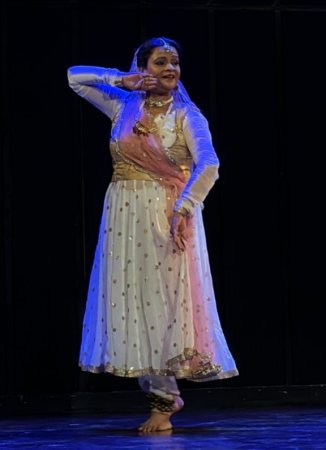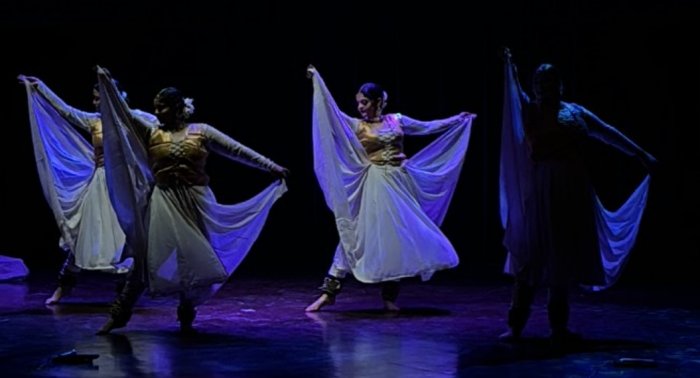
|   |

|   |
Bhav geeti - Kasturika Mishra e-mail: kasturikafeministpoetry@gmail.com October 15, 2024 Kathak has always been a dance associated with Havelis, kothis and religious ceremonies. Depending on the creator/God/cultural context of region or locality it has traditionally been taught under strict supervision of royal dancers or gurus. So much so that even emperors and rulers like Wajid Ali Shah have profusely indulged in learning, composing and performing Kathak dance. The rulers of the times patronized and learnt from tawaif, courtesan who in turn strictly controlled and preserved their lineage and clan. Patronage of Kathak amongst the royals is a legendary phenomenon. No wonder then that in modern times it has a lasting impression on the oeuvre of torch bearer dancer, Rani Khanum. In a scintillating packed one and half hour recital Rani Khanum along with her disciples touched upon the nuances of an integral component of Kathak, "Bhav" ie, emotions.  Rani Khanum The context of the items of the evening centered around rivers, rains, love, despair and pain, quoting from Urdu literature. Use of melancholic raags and minimal musical intervention enhanced the group composition with placement of tukdas and padhants by the talented dancers of Aamad Repertory namely Shikha Sharma, Riddhima Singh, Subhangee Goel. In the choreography "Namami Yamuna" the hymn Yamunaastakam was featured. On the note in reverence to Ma Yamuna, Rani Khanum, Lavanya Gupta, Priyanka Shah evoked the journey of Yamuna river as a caregiver in spite of many obstructions and providing a purpose to life. In the second composition aptly titled "Andaz-e-Raqs," Nisha Keshari, Shubhangee Goyal, Kratika Singh gyrated in slow movements swirling and displaying the extra folds in the costume of the lower torso. The entire look and setting on stage were greatly influenced by Persian paintings.  In subsequent choreographic pieces, Rani Khanum dwelled upon the prevalence of high voltage feelings in the couplet "Tere rukshar pe wo kale til ka matlab" literally meaning the presence of the mole on your face. She demonstrated for the audience the chut ki tihai, twitching of rain drops falling on the face of a forlorn lover, the influence of ornamented dressing up for meeting one's desired men. She deftly accentuated this suggestive couplet in the next item through a ghazal of Faiz Ahmad Faiz. In the ghazal she emphasized the need to give a voice to pain, and how a strong personality is established in silence. The lover is lamenting and imploring divinity to save his soul and body to an eternal zenith. She concluded the evening with crisp 16 beats foot work selected from the Lucknow repertoire.  @Kasturika Mishra is a poet, writer, and dance critic. |